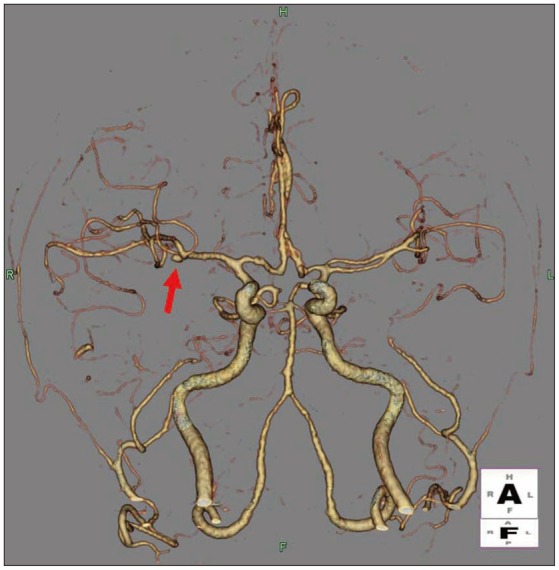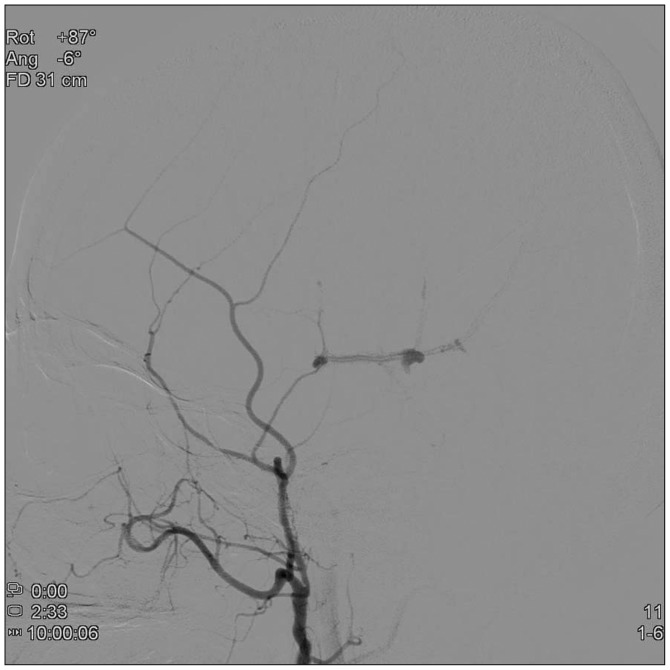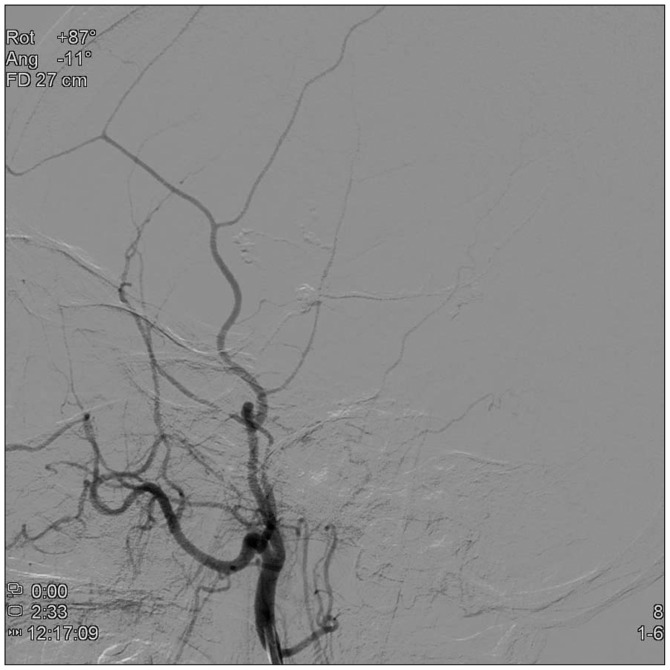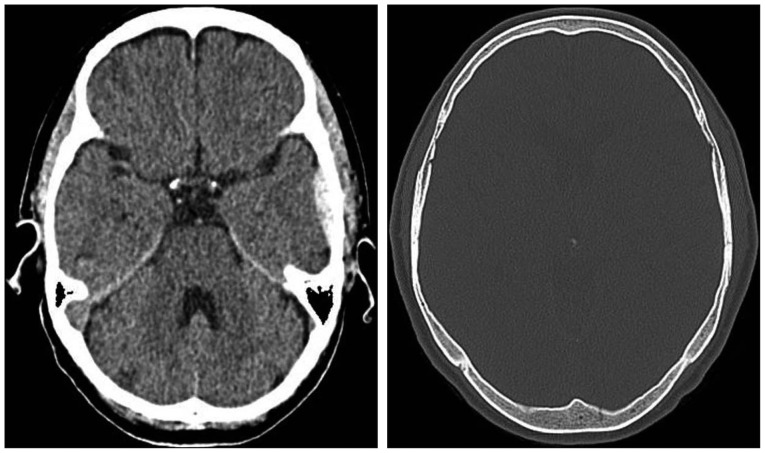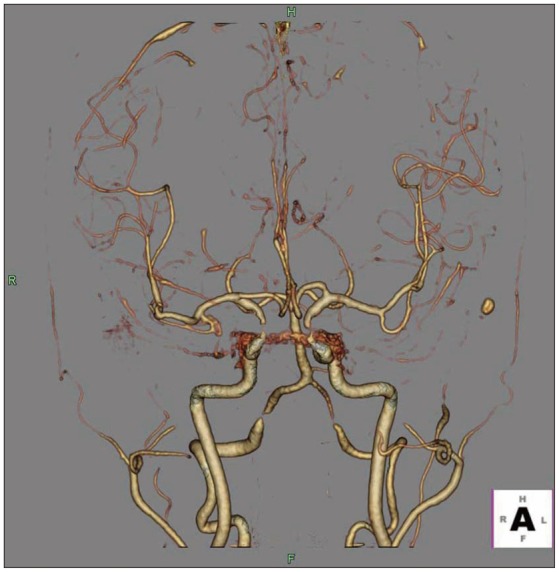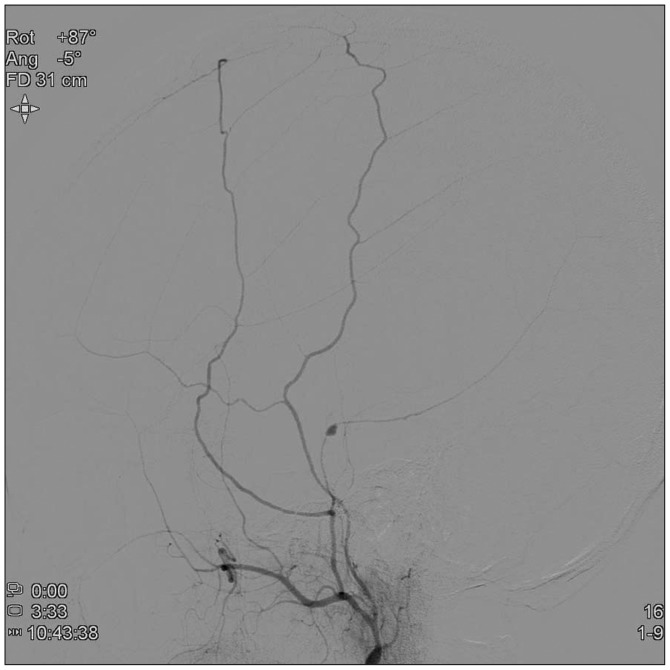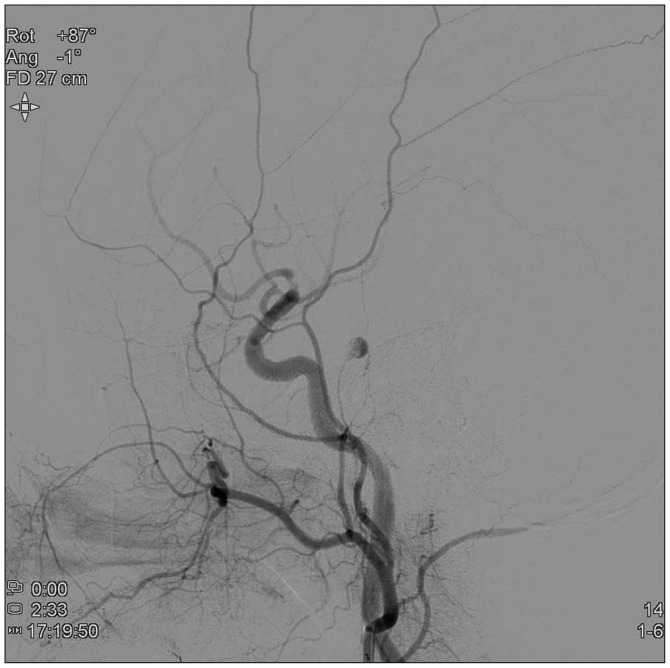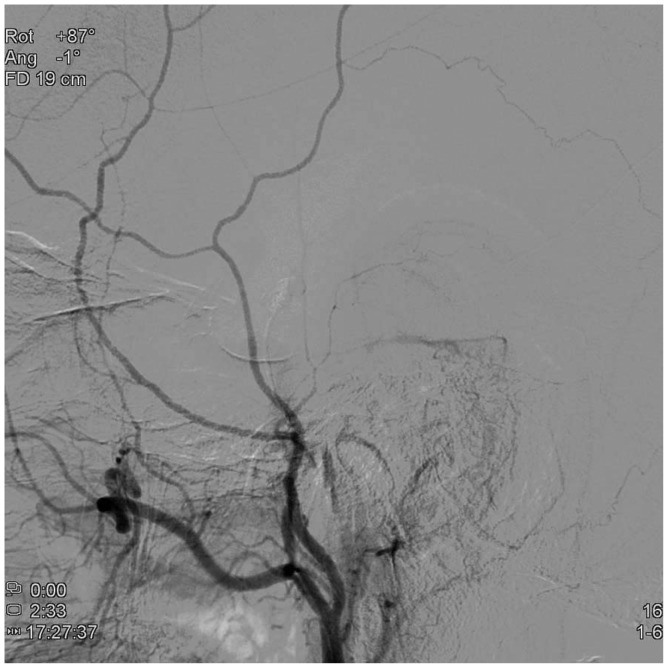J Korean Neurosurg Soc.
2014 Nov;56(5):423-427. 10.3340/jkns.2014.56.5.423.
Angiographically Progressive Change of Traumatic Pseudoaneurysm Arising from the Middle Meningeal Artery
- Affiliations
-
- 1Department of Neurosurgery, Konyang University Hospital, Daejeon, Korea. ljy0731@kyuh.ac.kr
- 2Department of Neurosurgery, Graduate School of Medicine, Kyung Hee University, Seoul, Korea.
- KMID: 2018102
- DOI: http://doi.org/10.3340/jkns.2014.56.5.423
Abstract
- Traumatic pseudoaneurysms of the middle meningeal artery (MMA) are rare phenomenon, which are usually associated with head trauma such as an underlying skull fracture. They were usually known to cause acute or delayed epidural hematomas but can be associated with subdural, subarachnoid, or even intracerebral hemorrhage. Sometimes, a high mortality rate was reported in these circumferences. But the natural course of these pseudoaneurysms is not well recognized. The indication and guideline of treatment for pseudoaneurysm are also unclear. This report describes a rare case of angiographically progressive change of traumatic pseudoaneurysm of the middle meningeal artery for one week, which was treated with endovascular embolization.
Keyword
MeSH Terms
Figure
Cited by 1 articles
-
Traumatic middle meningeal artery pseudoaneurysm: Case report and review of literature
Nadeem Mohammed, Harsh Deora, Abhinith Shashidhar, Malla Bhaskara Rao
J Cerebrovasc Endovasc Neurosurg. 2025;27(1):60-65. doi: 10.7461/jcen.2024.E2024.04.004.
Reference
-
1. Albert FK, Oldenkott P, Sigmund E. [Subarachnoid hemorrhage and intracerebral hematoma in injury of the middle meningeal artery (aneurysma spurium)]. Zentralbl Neurochir. 1989; 50:153–156. PMID: 2701912.2. Aoki N, Sakai T, Kaneko M. Traumatic aneurysm of the middle meningeal artery presenting as delayed onset of acute subdural hematoma. Surg Neurol. 1992; 37:59–62. PMID: 1727086.
Article3. Benoit BG, Wortzman G. Traumatic cerebral aneurysms. Clinical features and natural history. J Neurol Neurosurg Psychiatry. 1973; 36:127–138. PMID: 4691685.
Article4. Bruneau M, Gustin T, Zekhnini K, Gilliard C. Traumatic false aneurysm of the middle meningeal artery causing an intracerebral hemorrhage : case report and literature review. Surg Neurol. 2002; 57:174–178. discussion 178. PMID: 12009543.
Article5. Higazi I, el-Banhawy A, el-Nady F. Importance of angiography in identifying false aneurysm of the middle meningeal artery as a cause of extradural hematoma. Case report. J Neurosurg. 1969; 30:172–176. PMID: 5780889.
Article6. Kähärä VJ. Middle meningeal artery aneurysm. Case illustration. J Neurosurg. 1999; 91:518. PMID: 10470835.7. Kawaguchi T, Kawano T, Kaneko Y, Ooasa T, Ooigawa H, Ogasawara S. Traumatic lesions of the bilateral middle meningeal arteries--case report. Neurol Med Chir (Tokyo). 2002; 42:221–223. PMID: 12064157.
Article8. Kim JH, Yim MB, Lee CY, Kim IM. Surgical management of pseudoaneurysm. J Korean Neurosurg Soc. 2001; 30:307–318.9. Kuhn RA, Kugler H. False aneurysms of the middle meningeal artery. J Neurosurg. 1964; 21:92–96. PMID: 14113957.
Article10. Lim DH, Kim TS, Joo SP, Kim SH. Intracerebral hematoma caused by ruptured traumatic pseudoaneurysm of the middle meningeal artery : a case report. J Korean Neurosurg Soc. 2007; 42:416–418. PMID: 19096582.
Article11. Meder JF, Gaston A, Merienne L, Godon-Hardy S, Fredy D. Traumatic aneurysms of the internal and external carotid arteries. One case and a review of the literature. J Neuroradiol. 1992; 19:248–255. PMID: 1464777.12. Namba K, Ban S, Oda Y, Tazumi M, Ogata M. [Case of traumatic false aneurysm of the middle meningeal artery with epidural hematoma--comparison with a case resulting in spontaneous thrombosis]. Rinsho Shinkeigaku. 1972; 12:165–170. PMID: 4674556.13. New PF. True aneurysm of the middle meningeal artery, cranial Paget's disease and hypertension : a triad. Clin Radiol. 1967; 18:154–157. PMID: 6023347.
Article14. O'Neill OR, Barnwell SL, Silver DJ. Middle meningeal artery aneurysm associated with meningioma : case report. Neurosurgery. 1995; 36:396–398. PMID: 7731521.15. Parkinson D, West M. Traumatic intracranial aneurysms. J Neurosurg. 1980; 52:11–20. PMID: 7350269.
Article16. Sandin JA 3rd, Salamat MS, Baskaya M, Dempsey RJ. Intracerebral hemorrhage caused by the rupture of a nontraumatic middle meningeal artery aneurysm. Case report and review of the literature. J Neurosurg. 1999; 90:951–954. PMID: 10223464.
Article17. Srinivasan A, Lesiuk H, Goyal M. Spontaneous resolution of posttraumatic middle meningeal artery pseudoaneurysm. AJNR Am J Neuroradiol. 2006; 27:882–883. PMID: 16611783.
- Full Text Links
- Actions
-
Cited
- CITED
-
- Close
- Share
- Similar articles
-
- Intracerebral Hematoma Caused by Ruptured Traumatic Pseudoaneurysm of the Middle Meningeal Artery: A Case Report
- Traumatic middle meningeal artery pseudoaneurysm: Case report and review of literature
- Rupture of a Middle Meningeal Artery Pseudoaneurysm in Moyamoya Syndrome Related with Tuberculous Meningitis
- Clinical Experiences of Traumatic Intracranial Aneurysms
- Traumatic Intracerebral and Subarachnoid Hemorrhage Due to a Ruptured Pseudoaneurysm of Middle Meningeal Artery Accompanied by a Medial Sphenoid Wing Dural Arteriovenous Fistula


